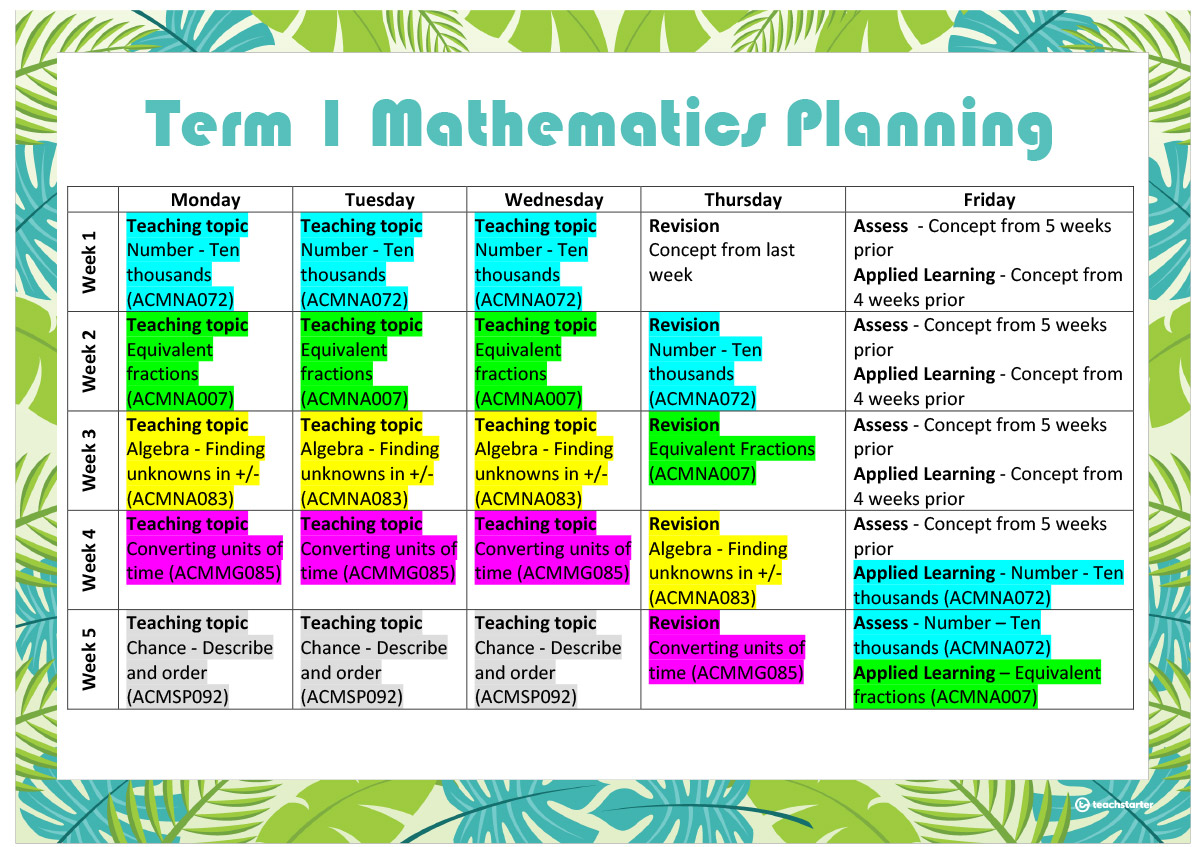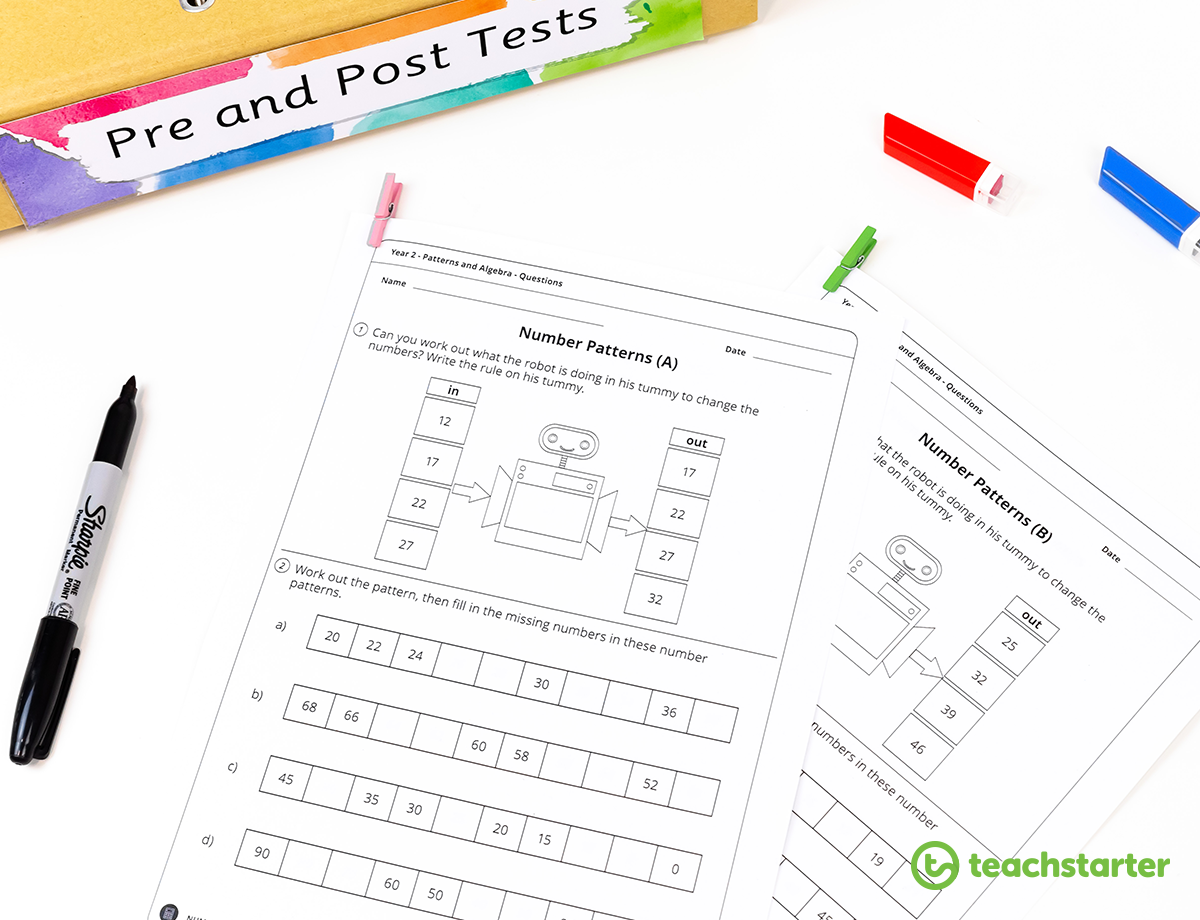Teaching and planning maths in the classroom can be a challenge for teachers, mainly due to the amount of content that needs to be taught. Every teacher understands the importance of developing numeracy skills but the sheer breadth of the curricula and the limitations on time, often lead to a concern that concepts aren’t given enough opportunity to be fully consolidated. This often means that the new concepts aren’t retained. If concepts aren’t being retained, they need to be revised, which takes away time from teaching new concepts and a vicious cycle begins!
This was a very real concern for me in my classroom and I soon realised that I needed to teach smarter, not harder.

I constructed a teaching sequence that allowed me to develop a concept, revise it, apply it to a real word setting and assess it over a five-week period, whilst still teaching one concept per week on average.
And now, I would like to share that with you…
How to Successfully Plan a Term of Mathematics
Colour coding at it’s best featured in this 5-week plan of how I would plan my mathematics concepts in my class! By including the curriculum code in your timetable you can easily search on Teach Starter using that code to instantly see what resources we have available to help you teach each concept!
I have used concepts from Year 4 Mathematics to model the structure on the table below.
Take a look and then I’ll explain the mechanics of how it works. Follow ‘Number – Ten thousand’ to best see how each individual concept progresses.

Overview of Mathematics Term Planning
New concepts are taught on three consecutive days, preferably at the start of the week, when young minds are most productive.
That concept is then revised on the fourth day of the following week.
I liked to use mathematics worksheets or something similar so that I could have a work sample at the end of the lesson that I could then use to review and assess how each student has progressed (our Pre and Post Tests may be suitable for this).

This concept is then left for a week. On the fifth day of the next week, the previous concept is touched on again, this time as an applied learning situation.
This could be a mathematics problem-solving activity, a hands-on task, inquiry-based lesson, multiple intelligence rotations or a mathematics investigation. This lesson is usually half the time of a normal session.
Then, five weeks after the concept was introduced, it is assessed on the fifth day, in the other half of the session that is shared with another concept’s applied learning lesson.
Clear as mud?
It gets easier – utilise our editable Timetable templates to plan out your term. So you know what you’re teaching on what day!
Teaching Mathematics Concepts in an Effective Way
The temptation when teaching these content heavy subjects is to punch them out as quickly as possible: introduce, develop, consolidate, revise, apply and assess, all in one or two weeks.
This approach will give you a nice recency effect for your testing i.e. the students remember more of the work because it has been recently studied. However, learning concepts over short periods of time sacrifices knowledge retention which, given the progressive nature of the curricula, is not ideal.
My sequence still teaches each concept in five days, plus an assessment, but the learning experiences are spaced out.
The breaks in between are deliberate and cognitively beneficial as they give the brain time to process the information before applying it again. It also helps develop better connections between new and existing knowledge.
Furthermore, stretching out the learning creates a primacy effect i.e. what is learned first is recalled more easily, hence the concentrated teaching at the start of the sequence. Knowledge learned in the middle of a sequence is recalled less readily, hence the week off at this stage of learning. Revisiting and elaborating on the concept later in the sequence helps consolidation and does give a recency effect, but with a more solid base underlying it.
Finally, by extending the teaching sequence and creating a primacy and recency effect, you have provided the perfect foundation for the new concept to be retained, the very goal of all knowledge acquisition. Boom!

What are the Benefits?
I found there were several advantages to using this planning approach.
- Students appeared to retain new learning more readily which led to better and more consistent results on assessments.
- They became more engaged in the lessons, perhaps because of the variety of activities and concepts in one week.
- The students, and I, became more mentally flexible and more willing to take on new learning challenges.
- The class was more organised, which in turn helps with behaviour and time management.
- By breaking up the concepts, you are afforded more time to check-in and assist your students. I used the revision task as a piece of formative assessment. Students who were struggling were identified early and then, in the ‘week off’ after revision, I arranged for a support staff member to go over the concept with them again. The applied learning session then allowed me to have another look at those students and implement more support in the week leading up to the assessment if required.
- Assessment anxiety was reduced as tests were broken down to small, manageable tasks. I also had a several work samples, collected over time, which helped me with report cards and parent-teacher interviews.
This approach also worked well for English. I broke the subject into four parts: reading, writing, grammar and spelling. I then applied the same structure to teaching concepts within these strands and found it was also successful.
Identifying the Challenges
Adopting a new approach to anything will always be a little difficult at first. Hopefully, by identifying some of the potential challenges, you will be able to head them off before they even become a problem!
Firstly, there is more planning required ‘up-front’ with this approach so you will definitely need to be organised. However, once it is set up, the process flows quite nicely. The system is also quite flexible. If I found that I needed to teach a concept earlier or later in the sequence, it was simply a matter of moving topics around. This process is much easier if you are using a digital resource for your planning.
You may like to check out our editable timetable resources all available in Microsoft Word.
Deciding on the sequence of topics can be difficult. In my experience, this was usually decided by the collective teaching team in planning times but, if that wasn’t available, I found textbooks quite useful. Assuming they have been written to your specific curriculum, they will have been sequenced accordingly. Just looking at the contents page usually gave me enough guidance!
The sequence also may need some tweaking at the start and end of a teaching cycle. At the start of the year, I would include topics from the previous year that I found needed refreshing after the summer break. These topics would be taught in the revision, applied learning and assessment slots until the new topics worked their way through the sequence. Coming up to reporting deadlines and end of terms, I again structured the sequence so that easier/lighter concepts were at the end and could be taught and assessed in less time if needed. Where there were reporting and assessment deadlines during the year, I just organised the sequence so that the assessments required would be completed by that time.
Finally, I did encounter a few occasions where my school insisted on one, whole assessment or test at the end of the term. I found the sequence still worked quite well and I still incorporated the assessment lesson but I simply counted this as a formative assessment. I also created a revision week prior to the test. Again, having several work samples helped identify particular areas for consolidation and allowed me to give targeted feedback to the students.
Final Words from Paul
I put this structure together using my background in psychology, teaching experiences, input from some great mentors and a good dose of trial and error! I wanted to share this approach as I believe it will actually buy you time in the short term, save you time in the long run and help make your classroom buzz.
Teach Starter has a multitude of worksheets and teaching resources that can be used in any part of the learning sequence. We are adding new lessons and unit plans regularly so keep an eye out for these as well.
So why not try this idea at the start of the next term, or even right now?! We’d love to hear how it works for you. Feel free to tell us or even ask a question in the comment section below.
It’s a tough gig being a teacher so, as I said before, we have to teach smarter, not harder.
Better yet, teach smarter with Teach Starter!








Comments